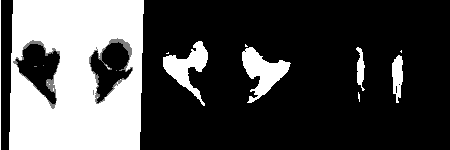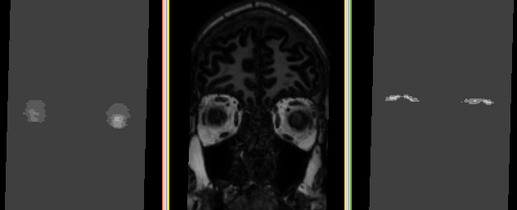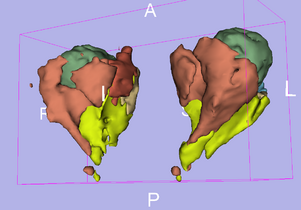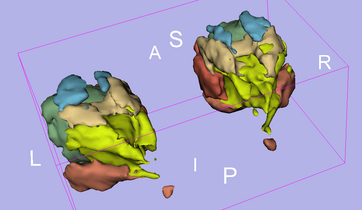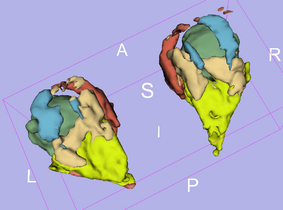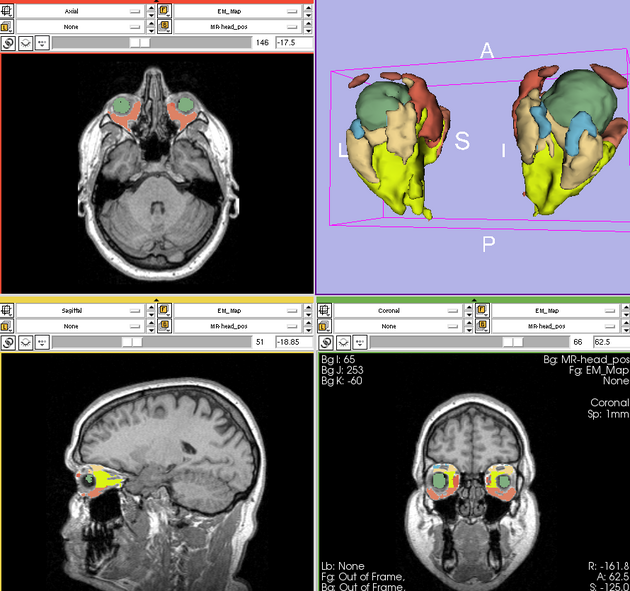Difference between revisions of "EMSegmenter-Tasks:Human-Eye"
(→Atlas) |
m (Text replacement - "\[http:\/\/www\.slicer\.org\/slicerWiki\/index\.php\/([^ ]+) ([^]]+)]" to "$2") |
||
| (8 intermediate revisions by 2 users not shown) | |||
| Line 3: | Line 3: | ||
=Description= | =Description= | ||
Single channel automatic segmentation of t1w-MRI brain scans into the major tissue classes (gray matter, white matter, csf). The task can only be applied to t1w brain scan showing parts of the skull and neck. The pipeline consist of the following steps: | Single channel automatic segmentation of t1w-MRI brain scans into the major tissue classes (gray matter, white matter, csf). The task can only be applied to t1w brain scan showing parts of the skull and neck. The pipeline consist of the following steps: | ||
| − | * Step 1: Perform image inhomogeneity correction of the MRI scan via [ | + | * Step 1: Perform image inhomogeneity correction of the MRI scan via [[Modules:N4ITKBiasFieldCorrection-Documentation-3.6|N4ITKBiasFieldCorrection]] (Tustison et al 2010) |
* Step 2: Register the atlas to the MRI scan via [[Modules:BRAINSFit| BRAINSFit]] (Johnson et al 2007) | * Step 2: Register the atlas to the MRI scan via [[Modules:BRAINSFit| BRAINSFit]] (Johnson et al 2007) | ||
* Step 3: Compute the intensity distributions for each structure <BR> | * Step 3: Compute the intensity distributions for each structure <BR> | ||
| Line 11: | Line 11: | ||
=Anatomical Tree= | =Anatomical Tree= | ||
| − | + | * root | |
| + | ** 1 (dark blue) : eye globe | ||
| + | ** 2 (pink) : fat tissue | ||
| + | ** 4 (blue) : superior oblique muscle | ||
| + | ** 5 (red) : medial rectus muscle | ||
| + | ** 6 (green) : lateral rectus muscle | ||
| + | ** 8 (yellow) : inferior rectus muscle | ||
| + | ** 9 (violet) : superior rectus muscle | ||
| − | * | + | * not used |
| − | |||
| − | |||
** 3 (white) : not used | ** 3 (white) : not used | ||
| − | + | ** 7 (azure blue) : not used | |
| − | + | ** 10 (olive green) : not used | |
| − | |||
| − | ** 7 (azure blue) : | ||
| − | |||
| − | |||
| − | ** 10 (olive green) : | ||
=Atlas= | =Atlas= | ||
| − | Atlas was generated based on 5 scans and corresponding segmentations provided by Raphaël Olszewski, l'Université catholique de Louvain à Louvain-La-Neuve, | + | Atlas was generated based on 5 scans and corresponding segmentations provided by Raphaël Olszewski, l'Université catholique de Louvain à Louvain-La-Neuve, Belgium [http://www.stom.ucl.ac.be/]. We registered the scans to a preselected template via the [[Modules:AtlasCreator|atlas creator]] using the fixed template approach by (Warfield et al. 2001.) <BR> |
Image Dimension = 256 x 256 x 100 <br> | Image Dimension = 256 x 256 x 100 <br> | ||
Image Spacing = 1 x 1 x 1 <BR> | Image Spacing = 1 x 1 x 1 <BR> | ||
| Line 32: | Line 32: | ||
<gallery perrow=1: widths=630px : heights=210px> | <gallery perrow=1: widths=630px : heights=210px> | ||
Image:EMS HumanEyeAtlasLabels.png | Image:EMS HumanEyeAtlasLabels.png | ||
| + | Image:EMS Human Eye Atlas plus template.png | ||
</gallery> | </gallery> | ||
| Line 47: | Line 48: | ||
=Collaborators= | =Collaborators= | ||
| − | + | Dr Raphael Olszewski DDS,MD,PhD, Department of oral and maxillofacial surgery, Cliniques universitaires saint Luc, Université catholique of Louvain, Brussels, Belgium [http://www.stom.ucl.ac.be/] | |
=Acknowledgment= | =Acknowledgment= | ||
Latest revision as of 02:22, 27 November 2019
Home < EMSegmenter-Tasks:Human-EyeReturn to EMSegmenter Task Overview Page
Contents
Description
Single channel automatic segmentation of t1w-MRI brain scans into the major tissue classes (gray matter, white matter, csf). The task can only be applied to t1w brain scan showing parts of the skull and neck. The pipeline consist of the following steps:
- Step 1: Perform image inhomogeneity correction of the MRI scan via N4ITKBiasFieldCorrection (Tustison et al 2010)
- Step 2: Register the atlas to the MRI scan via BRAINSFit (Johnson et al 2007)
- Step 3: Compute the intensity distributions for each structure
Compute intensity distribution (mean and variance) for each label by automatically sampling from the MR scan. The sampling for a specific label is constrained to the region that consists of voxels with high probability (top 95%) of being assigned to the label according to the aligned atlas.
- Step 4: Automatically segment the MRI scan into the structures of interest using EM Algorithm (Pohl et al 2007)
Anatomical Tree
- root
- 1 (dark blue) : eye globe
- 2 (pink) : fat tissue
- 4 (blue) : superior oblique muscle
- 5 (red) : medial rectus muscle
- 6 (green) : lateral rectus muscle
- 8 (yellow) : inferior rectus muscle
- 9 (violet) : superior rectus muscle
- not used
- 3 (white) : not used
- 7 (azure blue) : not used
- 10 (olive green) : not used
Atlas
Atlas was generated based on 5 scans and corresponding segmentations provided by Raphaël Olszewski, l'Université catholique de Louvain à Louvain-La-Neuve, Belgium [1]. We registered the scans to a preselected template via the atlas creator using the fixed template approach by (Warfield et al. 2001.)
Image Dimension = 256 x 256 x 100
Image Spacing = 1 x 1 x 1
Result
Collaborators
Dr Raphael Olszewski DDS,MD,PhD, Department of oral and maxillofacial surgery, Cliniques universitaires saint Luc, Université catholique of Louvain, Brussels, Belgium [2]
Acknowledgment
The construction of the pipeline was supported by funding from NIH NCRR 2P41RR013218 Supplement.
Citations
- Tustison NJ, Avants BB, Cook PA, Zheng Y, Egan A, Yushkevich PA, Gee JC N4ITK: Improved N3 Bias Correction, IEEE Trans Med Imag, 2010
- Pohl K, Bouix S, Nakamura M, Rohlfing T, McCarley R, Kikinis R, Grimson W, Shenton M, Wells W. A Hierarchical Algorithm for MR Brain Image Parcellation. IEEE Transactions on Medical Imaging. 2007 Sept;26(9):1201-1212.
- S. Warfield, J. Rexilius, P. Huppi, T. Inder, E. Miller, W. Wells, G. Zientara, F. Jolesz, and R. Kikinis, “A binary entropy measure to assess nonrigid registration algorithms,” in MICCAI, LNCS, pp. 266–274, Springer, October 2001.
- Johnson H.J., Harris G., Williams K. BRAINSFit: Mutual Information Registrations of Whole-Brain 3D Images, Using the Insight Toolkit, The Insight Journal, July 2007
